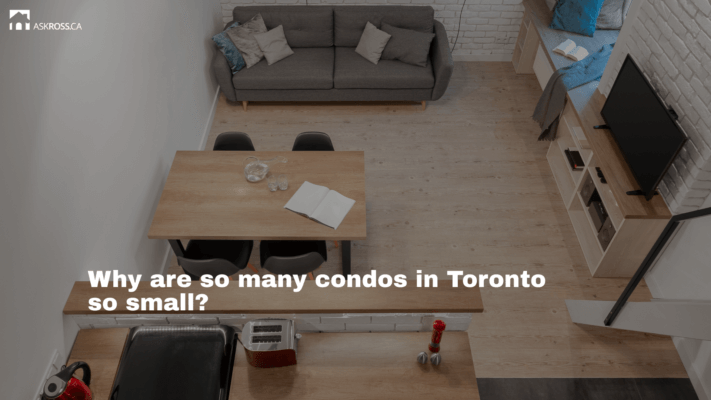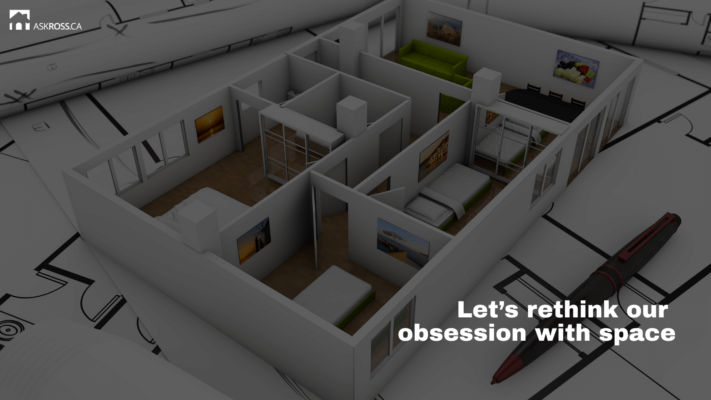
Published: May 2nd, 2025 • Last Updated: June 3rd, 2025
Author: Ross Taylor on AskRoss.ca
Are Toronto’s Micro-Condos Really Just “Dog Crates”?
There’s a term making the rounds in real estate discussions lately that I find both catchy and troubling: dog crate condo. It’s meant to describe those high-rise units under 500 square feet—often in downtown Toronto—and while I get the rhetorical flair, I think we need to take a step back.
It’s cynical. It’s misleading. And it distracts from the deeper issues Canadians should be focusing on, such as why housing has become so unaffordable in the first place, and how policy and planning have led us into this corner.
Framing these homes as “dog crates” unfairly ridicules the people who live in them and derails a necessary conversation about urban housing.
Jump to a specific section in this article ↓↓
- Why are so many condos in Toronto so small?
- Airbnb and the investor effect
- How does this compare to other Canadian cities?
- Why calling these homes “dog crates” is the wrong message
- Let’s rethink our obsession with space
- What conversations should we be having instead?
- A more constructive path forward

Why are so many condos in Toronto so small?
Ian Jones, president and founder of BGI Group, recently shared a thoughtful LinkedIn post on how Toronto’s condo market evolved into what we see today—and I felt compelled to weigh in with my own perspective.
The short answer: it’s not greed—it’s policy, economics, and market dynamics working together.
The impact of the 2006 Tall Buildings Guidelines
In 2006, Toronto’s Planning Department introduced guidelines that limited condo tower floor plates to 8,000 square feet.
Once you deduct elevator shafts, stairwells, and corridors, developers were left with only about 6,500 square feet of usable space per floor.
That forced a decision: either shrink unit sizes to fit more homes per floor or give up on high-rise residential buildings altogether.
Given the scarcity of developable land and escalating construction costs, shrinking unit sizes was the only viable path forward if projects were going to pencil out at all, let alone achieve the 15% profit margins typically required to secure financing.
↑↑ Back to the list at the top ↑↑

Airbnb and the investor effect
Then came the early 2010s: Airbnb exploded, presale investors flooded the market, and resale values shot up, creating the perfect storm that accelerated the construction of micro-condos. Developers had more reason than ever to build compact, rentable units.
This didn’t happen because developers were shortsighted—it was a rational response to real-world pressures.
Toronto became Ground Zero for this trend:
- The 2006 Tall Buildings Guidelines apply only to Toronto.
- The most dramatic concentration of condos under 500 square feet occurred downtown, particularly between 2010 and 2019.
- The Airbnb-fueled investor boom was heavily concentrated in Toronto during those peak years.
↑↑ Back to the list at the top ↑↑

How does this compare to other Canadian cities?
Other cities have experienced similar trends, but for different reasons, and with different outcomes.
Vancouver: affordability policies and land costs, not zoning
Vancouver, for instance, has also seen the rise of small condos—often referred to as “nano suites“ or “starter units“—but their backstory differs.
In Vancouver, micro-units emerged more from municipal affordability initiatives and sky-high land costs, rather than zoning restrictions like those in Toronto.
Interestingly, for much of the 2010s, Vancouver developers were actually building larger luxury units before market pressures pushed them toward smaller ones.
No micro-condo wave elsewhere
Cities like Montreal, Ottawa, Calgary, and Halifax? They’ve had no comparable boom in micro-condos.
While housing affordability is a concern nationwide, every city’s story is different. Zoning policies, building economics, and urban market dynamics have played out very differently outside of Toronto and Vancouver.
↑↑ Back to the list at the top ↑↑

Why calling these homes “dog crates” is the wrong message
Reducing these homes to “dog crates” unfairly ridicules the people who live in them. I know many individuals who live happily in these types of properties.
More concerning, this kind of language is causing casual observers to think all condos are cramped, soulless boxes. That’s simply not the case.
Real people choose condos—for real, valid reasons.
- Seniors who have happily downsized and now enjoy vibrant urban communities.
- Commuters who want a pied-à-terre in the city for work or leisure.
- Young adults who are thrilled to own or rent their first home.
- Access to building amenities that they might otherwise have to pay for additionally.
Condos offer freedom, flexibility, and accessibility, not a punishment. That’s not a downgrade—it’s a smart and intentional choice for many.
↑↑ Back to the list at the top ↑↑

Let’s rethink our obsession with space
Let’s also acknowledge that our cultural obsession with ever-bigger homes has played a part. Much of our perceived need for sprawling square footage stems from a lifetime of accumulating more clothing, furniture, toys, and knick-knacks than we actually use.
I’m reminded of my own childhood in Scotland, where a simple set of school clothes (two shirts to alternate) and a single set of play clothes were all we needed. We had no closets—nor did we require them.
After many years of living in a suburban, oversized house, I can say firsthand that there’s real joy in living more simply.
Today, I’m a happy condo dweller—and proud of it.
↑↑ Back to the list at the top ↑↑

What conversations should we be having instead?
Calling condos “dog crates” is a distraction. It lets us avoid the hard questions we really need to address:
- Why has affordability been allowed to erode so badly?
- Why are zoning and development policies still fundamentally disconnected from the realities of housing demand?
- How can we better balance growth, livability, and long-term urban planning?
When critics throw around catchy insults, it distracts from these pressing policy discussions. It lets the real structural challenges slip by unnoticed.
Words matter. When we call homes “dog crates,” we normalize the idea that some forms of housing and, by extension, the people who choose them, are inherently lesser.
That mindset helps no one—not the buyers, not the developers trying to innovate, and indeed not the policymakers grappling with complex urban challenges.
↑↑ Back to the list at the top ↑↑

A more constructive path forward
There’s no shame in a well-designed, thoughtfully lived-in condo. In fact, when done right, small units can foster vibrant communities, encourage sustainable living, and offer young Canadians their first crucial step onto the property ladder.
Instead of sneering, let’s channel our energy
- Let’s support better design so even small spaces feel bright, livable, and dignified.
- Let’s push for zoning reform to unlock more mid-rise and low-density housing options.
- Let’s demand innovative policies that are crafted with a clear understanding of their downstream effects, whether about floor plate restrictions or short-term rentals.
Toronto’s housing story is still being written. And while micro-units are now appearing in other cities in Canada, it’s Toronto that has truly become the poster child for this trend.
Our city may have kicked off this trend, but the lessons we learn here will matter across the country.
Let’s make sure we’re telling the real story.
↑↑ Back to the list at the top ↑↑

Ross Taylor Mortgages
If you want great service from someone you can trust – reach out to us today.
Get quick answers to your questions, no matter how difficult – 7 days a week.

 Apply For a Mortgage
Apply For a Mortgage